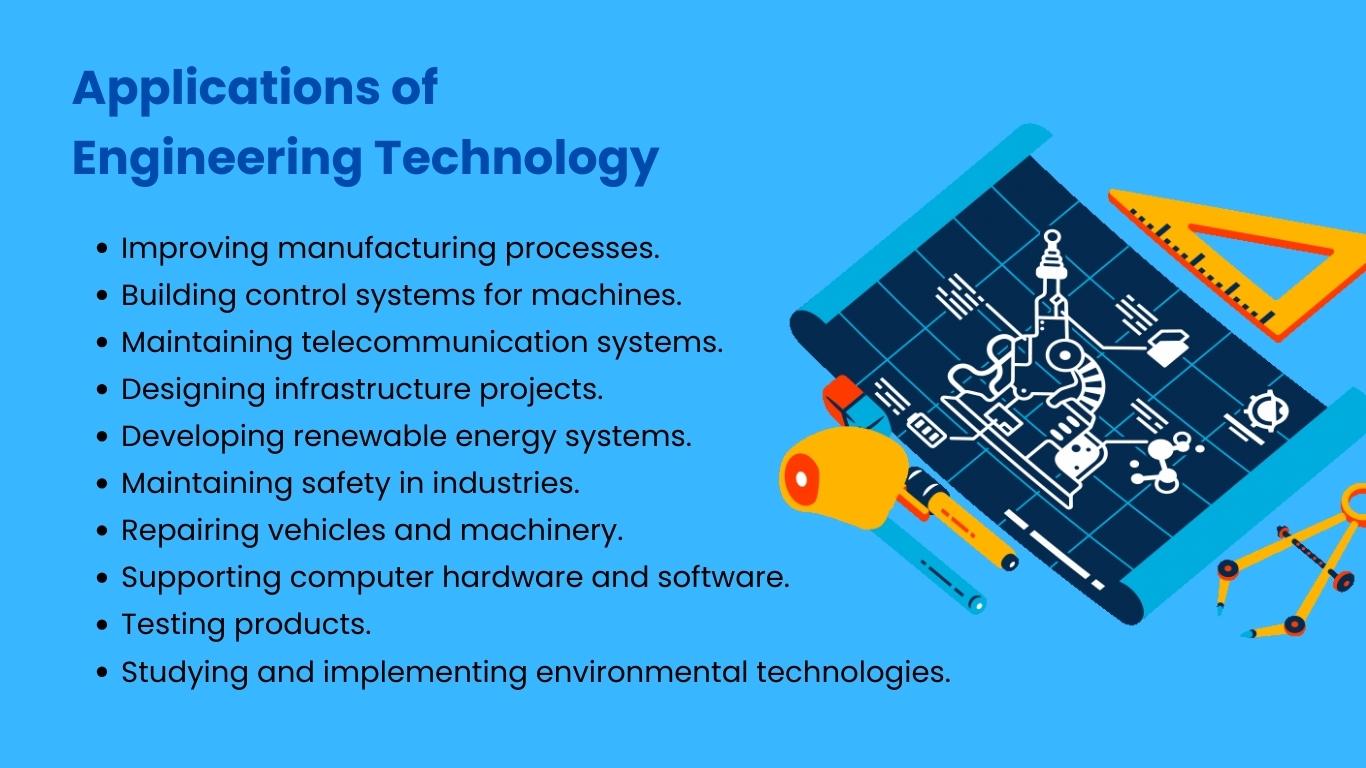
Engineering is everywhere. In fact, it is a driving force behind turning ideas into reality. Do not concur yet? Think about any invention, be it devices, structures, or vehicles, and you will find engineering in it. This is just the beginning. Engineering finds solutions to problems we are currently facing, as well as potential issues we can encounter in the future. We need to live in this world sustainably, and technology and engineering help us achieve this goal sooner. With that said, let’s explore the definition, examples, and application of engineering technology.
What is engineering technology?
Engineering technology is the application of scientific and engineering knowledge and methods combined with technical skills in support of engineering activities.

It lies more on the practical application side of engineering, as opposed to the more theoretical focus of traditional engineering. Engineering technologists often assist engineers but may also work independently in various industries, designing, developing, testing, and implementing various systems and solutions.
In engineering technology, the knowledge of math, science, engineering, and design principles are applied to convert a theoretical idea into practical applications. Firstly, the engineers carry out research and analysis to check whether the theoretical idea is feasible for application in the real world.
Once it is corroborated it can benefit the world, it is then designed, developed, and tested to convert into practical reality. This is to say, engineering technology implements pragmatic solutions for solving real-world problems.
Examples of engineering technology
Now that we know what engineering technology is, let’s look at its examples to understand it further. These are the examples of engineering technology:
1. Communication
In the telecommunication sector, engineering technology is used to manufacture equipment such as telephones and smartphones. The components such as variable resistance transmitters, electromagnetic receivers, induction coils, and microprocessors are being used.
Irrespective of the medium, wired or wireless, engineering technology creates and improves telecommunication systems. The other popular examples are GPS navigation and the Internet. Furthermore, fiber optic cables are utilized in telecommunication supporting the Internet and providing greater flexibility.
2. Health
Engineering technology drives health care towards advancement. It does so in the form of streamlining the processes and improving efficiency. This results in bringing innovative changes to the complex healthcare system for optimizing performance. An example of engineering technologies in health care is predicting the supply. That way, adequate health care is provided in the right place at the right time.
The other representative of this form of technology is in the prevention area. That’s where engineering technologies are being used to educate the population to make healthier choices. In the long run, this will prevent illnesses.
Healthcare institutions use engineering technologies to track behaviors. That way, the health outcomes of certain behaviors can be understood to create awareness. To sum up, engineering technology empowers the health care system.
3. Space
In space exploration, engineering technology is used to manufacture satellites, aircraft, and spacecraft. Additionally, it uses real-world knowledge and mathematical models to design space missions that further help in space exploration.
An example is the diffractionless beamed propulsion architecture proposed by the Texas A&M Engineering Experiment Station to reach Proxima Centauri in 42 years, which is 4.2343 light-years away. To cover the same distance, the current probe can take up to 6,300 years.
Engineering technology is used to design space missions such as interstellar travel that are currently only theoretical ideas. Many such hypothetical ideas are worked on and could convert into practical applications.
4. Manufacturing
Engineering procedures are applied in manufacturing processes. Engineering technology allows making cost-effective decisions. It helps to make the operations compact and keep processes connected to create a flow. This in turn eliminates unnecessary efforts and saves time. It brings automation, thus increasing productivity.
Along with this, it allows manufacturers to analyze the data to understand the needs of the target customer. These insights are beneficial in the product development process and crucial for long-lasting applications.
5. Transport
Engineering technology is applied in the planning, designing, operation, and maintenance of transportation systems. It supports roadways, waterways, intermodal operations, and railways. Besides considering the infrastructure and individual units of the system, it considers the users. This is to say that users, vehicles, and infrastructure are essential factors. This helps build a safe and efficient transportation system.
Some examples of engineering technology in transportation are advanced traffic control systems, advanced traveler information systems, and vehicle infrastructure integration. Alongside building new infrastructure, engineering technology updates the existing one to fulfill the demands of the users.
Applications of engineering technology

Having covered the examples of technologies in engineering, it’s time we look at their practical application. The following are the applications of engineering technology:
1. Engineering improves existing technologies
Engineering technologies bring continuous innovation to improve existing ones. Previously, we had to rely on prototypes to measure the performance of the system, which took lots of effort and time. With this form of technology, we have real-time data to work with, which brings improvements in a short period.
Additionally, it sends updates to the existing technology that keeps them relevant in our ever-changing world.
2. It solves complex problems
Engineering technologies aim to never give up when faced with problems. Therefore, it can resolve complex issues. The reverse engineering process is also used to find suitable solutions to a difficulty. This involves analyzing the concerns, designing the potential solutions, and building, and implementing them.
With the help of technology in engineering, the interdependent nature of the troubles can be understood to develop solutions irrespective of varying complexities.
3. Generates vast amounts of energy
Energy generation is crucial for our survival. Engineering and technology, when combined, draw inspiration from nature to bring novelty to this sector. This results in increased efficiency and a reduction in loss of energy. The technologies not only reduce the usage of resources but also lower emissions. New solutions are designed in a way to make the most of renewable sources of energy.
According to the American Society of Engineers, renewable energy sources provided 20% of electricity generation in 2020. Engineering technologies have the potential to increase this percentage and make our world sustainable.
4. Develop environmentally friendly methods
In the previous section, we pointed out that engineering technology lets us utilize renewable sources efficiently. That way, the methods and products developed are environmentally friendly. This reduces pollution while reducing the risk to human and animal health and the environment. Also, it does not compromise the efficiency of the procedure. Altogether, it promotes sustainability.
Finally, engineering technologies incorporate life-cycle thinking to develop solutions that protect the environment.
Types of Engineering Technology
Engineering means creating, building, or designing something. Thus, it entails scientific and technological aspects. Based on this, there are many types of engineering available. However, we will only focus on the core branches, which are as follows:
1. Civil Engineering
One of the oldest engineering disciplines is civil engineering, which deals with the construction, design, and maintenance of structures. Even from the start, it has seen the use of innovative technology. You can look at the Pyramids as a perfect example of the civil engineering technology of yesteryear. Today, we have the Burj Khalifa, a building that is 830 meters tall.
2. Chemical Engineering
Then we have chemical engineering, yet another example of how engineering technology has come a long way. Today, we have soap, detergents, shampoo, petroleum, lubricants, and so many other things that are a direct result of the excellence of chemical engineering.
3. Mechanical Engineering
Mechanical engineering is relevant to the development and production of machines and mechanical systems. It is backed by critical thinking and a problem-solving approach using the principles of math and physics.
Theoretical concepts are converted into practical applications via mechanical engineering technology. Any device that runs on wheels and has springs, axles, or screws is a byproduct of this discipline.
4. Electrical Engineering
Electrical engineering emerged as we made progress in our technology. Today, anything that can run on electricity or has any relevant application falls under electrical engineering technology. It is meant to design, test, and maintain electrical devices and systems, from anything as small as a microchip to satellites or power generators.
5. Industrial Engineering
And lastly, we have industrial engineering, another discipline that rose with the advent of technology. It is basically the amalgamation of electrical engineering and general business operations. It deals with every aspect of an industry, from manufacturing to logistics.
The aim is to reduce costs, improve quality, and introduce innovation. Industrial engineering technology has far-reaching effects that are felt across every sector of the economy.
Advantages and Disadvantages of Engineering Technology
We already discussed the advantages and disadvantages of civil engineering specifically. However, engineering, as a whole has a few of them. The following table highlights the various advantages and disadvantages of engineering technology:
| Advantages | Disadvantages |
|---|---|
| Drives innovation and progress | Renders older technology obsolete at a much faster rate |
| Enhanced productivity and quality | High initial set-up cost |
| Allows for automation and saves time | Renders people unemployed |
| Has made the world much smaller | Can cause issues like social isolation |
| Has made for a much safer working environment | Can lead to mental and physical health care problems |
| Made our lives much easier | Causes pollution |
| Made healthcare more effective, cheaper, and accessible | Has created new threats to society |